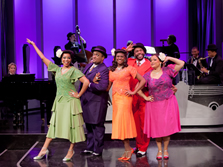The American Dance Festival‘s Argentine Festival continues through July 10 in Reynolds Theater with two intriguing dance theater programs. The 7:30 p.m. show comprises a single work by Gabriela Prado and Eugenia Estévez; the 9:30 p.m. show features two solos, by Edgardo Mercado and Susana Tambutti. Together, the two programs deliver a satisfying evening of movement-rich theatrical art, one that illustrates the connections and cross-fertilizations among some of Argentina’s avant-garde artists.
Prado and Estévez’ “Lleuve” (“Rain,” or “It Rains”) is a poetic meditation on Time’s flow and each individual’s life patterns — those repeated coalescings of choice and circumstance that create and define one’s life and sensibility — and the way they are studded with inexplicable, unforgettable incidents. Danced by Prado, Estévez, and Luis Biasotto (a member of Krapp, who was seen last week in “Olympica,” which he co-wrote and directed), “Lleuve” begins with the trio lounging in porch chairs on a slatted veranda, listening to the rain and gazing out at nothing, lost in their inner thoughts.
These three performers are so good that they can hold our attention while they do almost nothing. You have time to study their postures, evaluate the smallest gestures, and judge the exact angles and spaces between them. By the time Prado stands and begins to move, these people aren’t strangers to you any more. They have annexed your empathy with their quiet intimacy. The program notes talk about personal journals as being one of the sources of this work, and the piece does convey the feelings you might have if your oldest friend offered to let you read her journal — surprised, tender, a little trepidatious, but not voyeuristic.
There are wonderful sequences of movement and stillness in “Lleuve” that are enough on their own to make the work interesting. These include repeated passages that oscillate between spasmodic propulsion and a nerveless falling to earth, and a series of dances for the two women, in which one is the actor and one, the remembered action, her shadow or doppelganger. But the movement is just a part of this whole. Luis Biasotto wrote the haunting texts he speaks, now and then, as he wrings emotion from the smallest gestures and simplest acts. Beautiful plaintive music by Pablo Bronzini fills the air in other scenes, along with the swelling or slacking sounds of rain. The set, designed by Alicia Leloutre, with lighting by Eli Sirlin, creates an extraordinary space both safe and open to all possibilities. Some of the piece’s most beautiful images come when a dancer crosses the threshold from the glowing veranda to the rain-drenched exterior upstage, or comes in from the dark wet. Each of the elements is well and fully developed, but it is the unity of the aural, visual, spatial, kinetic and conceptual that makes this such a strong artwork.
In the second program, Edgardo Mercado’s “Plano Difuso” and Susana Tambutti’s “The Stab” demonstrated different solutions to the inherent problems of the extended dance solo. Mercado (who has worked under Tambutti in her Nucleodanza company), whose piece is danced by his assistant choreographer Pablo Castronovo, takes the technological route. In a stage world defined by animated digital images and projected light, the dancer is cloned by video. Soon there is swarm of simulacra, unrestricted by time and space, with whom he dances. He works so close to the invisible boundary with the virtual world that you begin to lose track of which is the real man. By the end the corporeal dancer seems less “real” than the digital copies populating the stage behind the stage.
The brilliance of this piece is due to the fusion of Mercado’s concept and excellent dance design with the multimedia work and music composition of his collaborator, Gabriel Gendin. This was the best use of video with dance I’ve seen yet. The technology for generating and projecting imagery has advanced so much that complex visual ideas can now be carried out without awkwardness, and Gendin exploits the potential of the medium in an exciting way. This is a very smart piece, immaculately executed and precisely timed.
“The Stab,” Susanna Tambutti’s well-known 1985 work, is danced here by the riveting Luciana Acuña, who dazzled us last week in Krapp’s performance (which she choreographed and directed, along with Biasotto). I will always prefer dance made with actual, rather than virtual, bodies, and Acuña is about as physical as you can get. (Acuña, who has a propensity for launching herself through the air, has danced with Brenda Angiel Aerial Dance Company, and has studied with Tambutti.) Here she manages to double herself, becoming both the stabber and the stabbee. This solo is also a duet.
“The Stab” is a dark entertainment, a tour de force of cabaret theatricality, and often very funny. (Imagine a woman in a corset and black-framed eyeglasses doing Saturday Night Fever moves to classic tango music.) Acuña, like all the dancers with Krapp, has highly developed her ability to metamorphosize from one image or character to another in the blink of any eye, with the aid of the simplest of props. That she can take two characters through their changes simultaneously is truly amazing. The piece makes a good finale for the Argentine Festival, even as it demonstrates that art feeds on art in a never-ending process.











